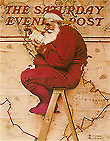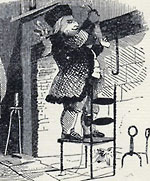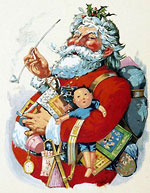 The first Europeans to arrive in the New World brought St. Nicholas. Vikings dedicated their cathedral to him in Greenland. On his first voyage, Columbus named a Haitian port for St. Nicholas on December 6, 1492. In Florida, Spaniards named an early settlement St. Nicholas Ferry, now known as Jacksonville. However, St. Nicholas had a difficult time during the 16th century Protestant Reformation which took a dim view of saints. Even though both reformers and counter-reformers tried to stamp out St. Nicholas-related customs, they had very little long-term success except in England where the religious folk traditions were permanently altered. Because the common people so loved St. Nicholas, he survived on the European continent as people continued to place nuts, apples, and sweets in shoes left beside beds, on windowsills, or before the hearth.
The first Europeans to arrive in the New World brought St. Nicholas. Vikings dedicated their cathedral to him in Greenland. On his first voyage, Columbus named a Haitian port for St. Nicholas on December 6, 1492. In Florida, Spaniards named an early settlement St. Nicholas Ferry, now known as Jacksonville. However, St. Nicholas had a difficult time during the 16th century Protestant Reformation which took a dim view of saints. Even though both reformers and counter-reformers tried to stamp out St. Nicholas-related customs, they had very little long-term success except in England where the religious folk traditions were permanently altered. Because the common people so loved St. Nicholas, he survived on the European continent as people continued to place nuts, apples, and sweets in shoes left beside beds, on windowsills, or before the hearth.
After the American Revolution, John Pintard, the influential patriot and antiquarian who founded the New York Historical Society in 1804, promoted St. Nicholas as patron saint of both society and city. In January 1809, Washington Irving joined the society and on St. Nicholas Day that same year, he published the satirical fiction, Knickerbocker's History of New York, with numerous references to a jolly St. Nicholas character. This was not the saintly bishop, rather an elfin Dutch burgher with a clay pipe. These flights of imagination are the source of the New Amsterdam St. Nicholas legends: that the first Dutch emigrant ship had a figurehead of St. Nicholas: that St. Nicholas Day was observed in the colony; that the first church was dedicated to him; and that St. Nicholas comes down chimneys to bring gifts. Irving's work was regarded as the "first notable work of imagination in the New World."
 The New York Historical Society held its first St. Nicholas anniversary dinner on December 6, 1810. John Pintard commissioned artist Alexander Anderson to create the first American image of Nicholas for the occasion. Nicholas was shown in a gift-giving role with children's treats in stockings hanging at a fireplace.
The New York Historical Society held its first St. Nicholas anniversary dinner on December 6, 1810. John Pintard commissioned artist Alexander Anderson to create the first American image of Nicholas for the occasion. Nicholas was shown in a gift-giving role with children's treats in stockings hanging at a fireplace.
1821 brought some new elements with publication of the first lithographed book in America, the Children's Friend. This "Sante Claus" arrived from the North in a sleigh with a flying reindeer. The annonymous poem and illustrations proved pivital in shifting imagery away from a saintly bishop. Sante Claus rewarded good behavior with gifts and punished bad conduct by leaving a "long, black birchen rod . . . direct(ing) a Parent's hand to use when virtue's path his sons refuse." The book also notably marked St. Claus' first appearance on Christmas Eve, rather than December 6th.
The jolly elf image received another big boost in 1823, from a poem destined to become immensely popular, "A Visit from St. Nicholas," now better known as "The Night Before Christmas."
Other artists and writers continued the change to an elf-like St. Nicholas, "Sancte Claus," or "Santa Claus," unlike the stately bishop saint. In 1863, during the Civil War, political cartoonist Thomas Nast began a series of annual black-and-white drawings in Harper's Weekly, based on the descriptions found in the poem and Washington Irving's work.

These drawings established a rotund Santa with flowing beard, fur garments, and an omnipresent clay pipe. Nast's Santa supported the Union and President Lincoln believed this contributed to the Union troops' success by demoralizing Confederate soldiers. As Nast drew Santas until 1886, his work had considerable influence in forming the American Santa Claus. Along with appearance changes, the saint's name shifted to Santa Claus—a natural phonetic alteration from the German Sankt Niklaus.
It's been a long journey from the Fourth Century Bishop of Myra, St. Nicholas, who showed his devotion to God in extraordinary kindness and generosity to those in need, to America's jolly Santa Claus, whose largesse often supplies luxuries to the affluent. However, if you peel back the accretions, he is still Nicholas, Bishop of Myra, whose caring surprises continue to model true giving and faithfulness.